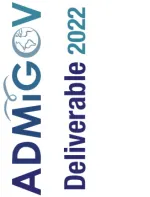Security costs: How the EU’s exclusionary migration policies place people on the move toward Italy and Greece at greater risk – a quantitative analysis

ADMIGOV Deliverable 5.2 (2022)
The findings in this study conducted by the Mixed Migration Centre (MMC) document the main protection risks faced by Asian and African migrants and refugees during their journeys along the Central Mediterranean Route (CMR), the Eastern Mediterranean Route (EMR), and the Western Balkan Route (WBR).
The CMR, the EMR, and the WBR each present their own specific protection risks, but also pose common challenges. Refugees and migrants who took part in MMC’s 4Mi survey perceive their journey to Europe to be fraught with severe risks, including detention, physical and sexual violence, robbery, bribery/extortion, and even death. Children are believed to be exposed to similar protection risks, including detention. The most commonly reported perpetrators of abuse and crime vary by route, with militias most prevalent on the CMR, and state actors on the EMR and the WBR, although criminal gangs are frequently reported across all three routes. Smugglers are a source of concern among respondents but are seldom considered to be the main perpetrators of abuse. The CMR—and Libya in particular—is more frequently reported as dangerous. On the EMR and the WBR, migrants and refugees often indicate Turkey, Iran, and Greece as locations where protection incidents are more likely to occur. Our respondents adopt a number of strategies to mitigate the risks they expect to face, such as travelling in groups and carrying cash, the latter assumingly to avoid having to work to pay for their journeys, often in exploitative conditions, or to be able to pay their way out of trouble.
A closer scrutiny of the findings allows for an analysis with regard to the European Union’s current approach to irregular migration across three major routes. Data suggest that this approach might be insufficient or even detrimental to migrants’ and refugees’ protection. The externalization of border controls to third countries such as Turkey, Libya, and Niger, more restrictive measures of entry implemented by EU Member States, and a shortage of legal pathways to Europe are likely to contribute to the prevalence of major protection risks faced or feared by 4Mi respondents. These measures place migrants and refugees at risk of arrest, detention, physical abuse, and deportation by EU Member States, and expose them to other abuses,
often committed by the very actors that the EU entrusts with the task of protecting migrants and refugees— such as certain state officials within the authorities of transit countries—or by local armed groups. In short, our analysis confirms that a securitized approach—one that often criminalizes refugees and migrants—in combination with a lack of legal and safe avenues of mobility, leads to a shrinking protection space for people on the move along key migration routes to and through Europe.